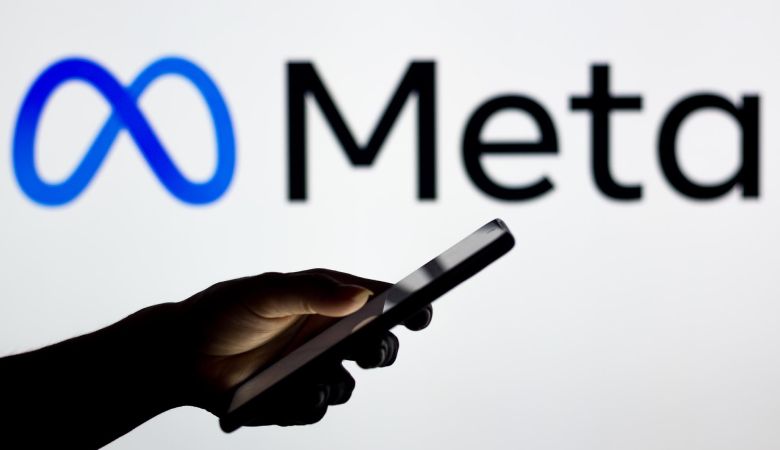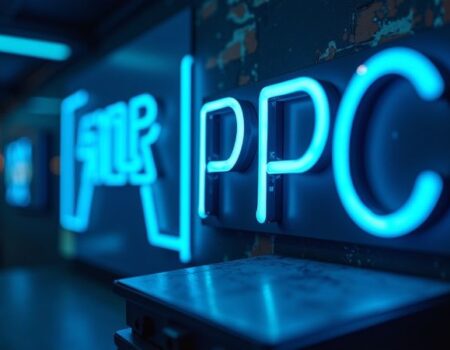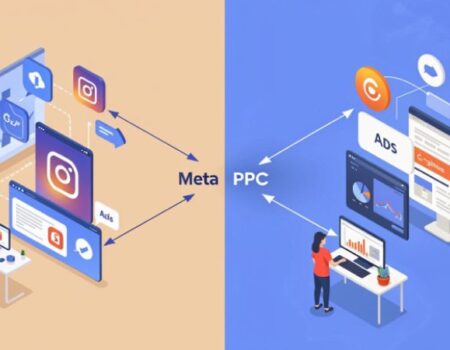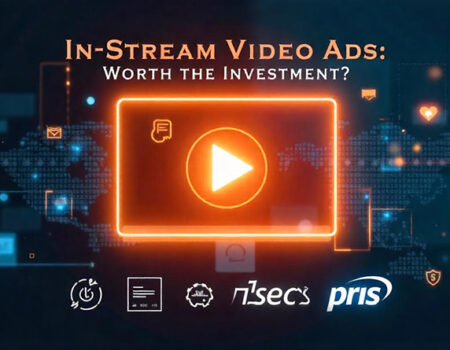Google Ads vs. Meta Ads: What’s The Key Difference?
Google Ads focuses on user intent.
Whether someone is searching for [best CRM for real estate agents] or [emergency plumber near me], Google captures users who are actively seeking solutions—making it a high-conversion platform.
Meta Ads (Facebook and Instagram) are all about discovery.
Your ads appear while users scroll casually—not necessarily looking to buy, but open to being inspired or influenced to take action.
This makes Meta Ads ideal for building brand awareness, promoting lifestyle products, and triggering impulse purchases.
Simply put, Google Ads works best when people already know what they want. Meta Ads are more effective when you’re trying to shape what they want.
When Google Ads is the Smarter Choice
Google Ads is perfect when there’s high search volume and strong buying intent.
Businesses in legal, home services, and B2B industries usually see better performance on Google because they address specific problems that people are actively researching.
While the cost-per-click (CPC) can be steep—home services see averages over $6.50, and legal industries go beyond $8.50 (as per 2024 data)—the quality of leads and potential returns justify the spend.
Google Ads also works well for ecommerce.
Someone typing [black corset sundress] or [best gaming laptop under ₹1,25,000] is already close to making a purchase, unlike someone simply browsing through Instagram.
Campaigns like Google Shopping Ads and Performance Max help streamline the buying process and boost ROI.
Local businesses also benefit from Google’s ecosystem—especially through Local Services Ads that directly connect potential customers with service providers.
When Meta Ads Deliver Better Results
Meta Ads excel when you’re looking to create demand—not just awareness, but also conversions.
For ecommerce brands, Meta often becomes a key sales driver, especially when the product is visually appealing, emotion-driven, or supported by high-quality creatives.
Tools like Advantage+ Shopping and dynamic product ads go beyond exposure—they can push immediate sales.
Meta Ads seamlessly combine discovery with action, making them ideal for product launches, lifestyle items, and visually attractive categories like fashion, home decor, or beauty.
With formats like Reels, Stories, and Carousels, brands can craft engaging narratives while driving conversions—all within a single swipe.
If you’re working with a limited budget, Meta is often the better pick. In 2024, the average CPC for Facebook Ads was ₹157 ($1.88), compared to Google’s ₹390 ($4.66).
Meta is also leaning heavily into AI to adjust to changes post-iOS 14. With tools like Conversions API and Advantage+ campaigns, advertisers can automate targeting and placements while coping with reduced third-party data.
Even B2C lead generation campaigns can perform well on Meta—especially when paired with strong visuals and clear CTAs.
Add in influencer content, product demos, or user-generated videos, and Meta can deliver far more than just awareness—it can drive real business growth.
What’s Changing in 2025 – And Why It Matters for Budget Allocation
As ad costs continue to rise, marketers in 2025 are being pushed to rethink how every rupee is spent.
With automation tools like Google’s Smart Bidding and Meta’s Advantage+ handling much of the heavy lifting—like bidding strategies and placements—budget allocation might seem easier. But these tools aren’t foolproof. Without the right creative inputs, clear campaign structure, and human supervision, automated systems can just as easily drain your budget as they can improve ROI (Return on Investment).
Another key shift is the growing dominance of short-form videos. Creatives like YouTube Shorts, Instagram Reels, and Facebook Stories are attracting more attention than static formats—and in many cases, they deliver better reach and cost efficiency.
First-party data has also become a cornerstone of successful PPC advertising.
Tools like Google’s Customer Match and Meta’s Conversions API rely heavily on quality data inputs. If you have a solid database of customer information, you can unlock better performance with advanced targeting strategies.
This is where scale plays a big role. Large brands, with access to thousands of customer records, can make the most of these tools. For small businesses, broader lookalike audiences or platform-led targeting still remain effective and often more feasible.
How to Approach Budget Allocation
There’s no fixed formula for how much to spend on Google Ads versus Meta Ads (formerly Facebook Ads). The right mix depends on several factors: your business goals, marketing funnel stage, product category, and customer behaviour.
Start with Customer Intent
If your customer is actively searching for a solution—say a personal injury lawyer, enterprise-level SaaS, or a plumber in the middle of the night—Google Ads is likely to offer the best results.
That’s because Google Ads captures high-intent traffic, right at the moment of need. In such cases, it’s often smart to allocate 70% or more of your ad budget to Google, especially when you want fast conversions.
Meta Ads, on the other hand, aren’t designed to capture bottom-of-funnel demand with the same precision.
Here’s a useful way to decide:
Ask yourself, “Does my customer already know they need this?” If the answer is yes, prioritise Google.
If you’re thinking, “I need to show my customer why they need this,” then Meta Ads should be your starting point.
Still unsure where your customers stand? Begin with keyword research. If search volumes are high, that’s your sign that Google deserves a bigger slice of your advertising strategy.
If You’re Building a Brand, Meta Ads Deserve More of Your Budget
Meta Ads perform especially well in categories where brand personality, lifestyle appeal, and storytelling influence customer decisions.
This makes platforms like Instagram and Facebook perfect for new product launches, entering saturated markets, or promoting visually appealing products like skincare, fashion, or home decor.
In such cases, it’s not unusual for brands to allocate up to 70% of their PPC advertising budget to Meta Ads—especially when the focus is on early-stage brand awareness or customer engagement.
Ecommerce Brands Should Balance Search and Social
For ecommerce businesses, your advertising strategy should be shaped by your product pricing and how your customers make buying decisions.
High-value or research-intensive items like fitness machines, electronics, or furniture tend to perform better on Google Ads, where buyers actively search and compare.
On the other hand, lower-priced, impulse-driven items such as jewellery, clothing, or quirky gifts often convert faster on Meta Ads. Here, users aren’t looking for something specific—but if they like what they see, they’re ready to buy.
A 50/50 budget split is a good place to start. From there, monitor your ROI (Return on Investment) and let the data guide whether to invest more in search or social.
Lead Generation Needs a Funnel-Focused Budget Plan
When it comes to lead generation, especially for B2B, Google Ads is typically the stronger performer thanks to high-intent search queries.
If your sales process is long or involves detailed consultations, Google should command the bulk of your budget allocation.
But for B2C lead generation—like building waitlists, email subscribers, or early sign-ups—Meta Ads can be a more cost-effective option. Its creative formats and targeting options allow you to warm up prospects at the top of the funnel.
Depending on your goals, a 60/40 or even 40/60 split between Google and Meta can work well.
Testing Is Your Most Reliable Budgeting Strategy
Budget allocation shouldn’t be static. The most effective approach is to reserve a portion of your budget for testing.
- Try out both platforms to see which creative, audience segment, copy, and format work best for your product or offer.
- Go beyond platform tests—experiment with price points, landing pages, lead magnets, and funnel steps.
- Even a ₹20,000 (~$250) test campaign, split evenly between Google Ads and Meta Ads, can provide far more clarity than a large campaign that’s locked into just one platform.
Partner with our Digital Marketing Agency
Ask Engage Coders to create a comprehensive and inclusive digital marketing plan that takes your business to new heights.
Contact Us
Keep Your Budget Flexible, Not Fixed
Smart advertisers don’t rely on rigid budget splits. They start with an assumption, test fast, and adjust weekly or monthly based on campaign results.
Factors like seasonal trends, product launches, ad fatigue, and even trending news can shift platform performance drastically.
If your entire advertising budget stays locked into a single platform all year, you’re likely missing opportunities—and possibly wasting spend.









